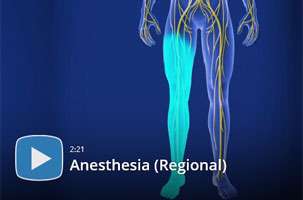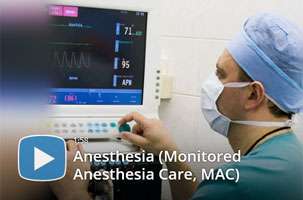Types of Anesthesia
There are four main categories of anesthesia used during surgery and other procedures: general anesthesia, regional anesthesia, sedation (sometimes called "monitored anesthesia care"), and local anesthesia. Sometimes patients may choose which type of anesthesia will be used.

Your physician anesthesiologist will discuss the types of anesthesia that would be safe and appropriate for the operation or procedure you need, and will explain your options clearly. Below, you will find more details and links to short videos that will give you more information.
-
General anesthesia is what people most often think of when they hear the word "anesthesia". During general anesthesia, you are unconscious and have no awareness or sensations. Many different medications may be used during general anesthesia. Some are anesthetic gases or vapors that are given through a breathing tube or a mask. Some medications are given through the IV to induce sleep, relax muscles, and treat pain.

Watch General Anesthesia Video
UCLA physician anesthesiologists work with each patient individually to determine which combination of medications is best, depending on your state of health, your other medical conditions, the medications you take, any allergies, and the type of surgery you are having.
The most frequent side effect of general anesthesia is drowsiness afterward. This typically goes away within the first hour or two after surgery ends. Some patients may experience a sore throat or nausea. If you have a history of motion sickness or nausea after prior operations, be sure to mention that to your physicians and nurses, as you may need medication before surgery to help prevent nausea afterward.
Serious reactions to general anesthesia are very rare. Your anesthesia team has immediate access to emergency medications to treat any kind of reaction, and will monitor your vital signs continuously throughout surgery and recovery.
-
Regional anesthesia makes an area of the body numb to prevent the patient from feeling pain. It can completely block sensation to the area of the body that requires surgery. The anesthesiologist injects local anesthesia (numbing medication) near the cluster of nerves that provides sensation to that area.

Watch Regional Anesthesia Video
Two very common types of regional anesthesia are spinal and epidural anesthesia. Either one may be used for childbirth, or for orthopedic procedures such as total knee and total hip replacement. Sometimes, an epidural catheter is left in place to allow continuous pain relief to be given for one or more days after surgery. This is common after surgery on the chest or abdomen, even when general anesthesia is used during the operation.
Nerve blocks are another type of regional anesthesia that can provide pain relief to a smaller area, such as an arm or leg. Examples include femoral nerve block to numb the thigh and knee, or a brachial plexus block to numb the shoulder and arm.
Having regional anesthesia for surgery doesn't mean that you have to be completely awake. Many patients prefer to receive sedation so that they can relax and doze off during the procedure. Sometimes regional anesthesia is used in combination with general anesthesia for major surgery on the chest or abdomen. This technique has the advantage that patients don't need as much opioid pain medication after surgery.
-
Sedation, also known as "monitored anesthesia care", is what people have often referred to in the past as "twilight". Medications are given, usually through an IV, to make the patient feel drowsy and relaxed. Different levels of sedation are possible, depending on the type of procedure and the patient's preference.

Watch Monitored Anesthesia Care Video
Under mild sedation, often used for eye surgery, a patient is awake and can respond to questions or instructions. With moderate sedation, the patient may doze off but awakens easily. Deep sedation is nearly the same as general anesthesia, meaning that the patient is deeply asleep though able to breathe without assistance. Deep sedation with a medication called propofol is often used for procedures such as upper endoscopy or colonoscopy.
-
Local anesthesia is the term used for medications such as lidocaine that are injected through a needle or applied as a cream to numb a small area. Local anesthesia alone may provide enough pain relief for limited procedures such as sewing up a deep cut or filling dental cavities. It is often used along with sedation during minor outpatient surgery. At the end of many operations, the surgeon may inject local anesthesia to provide additional pain relief during recovery.